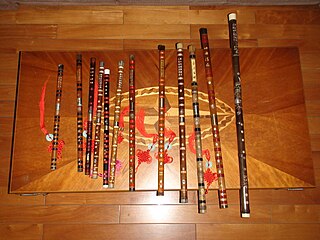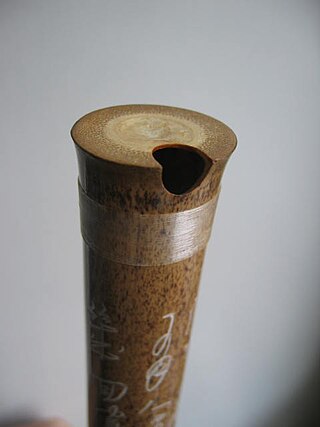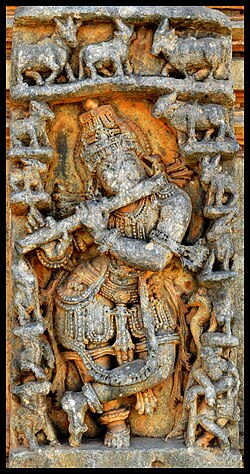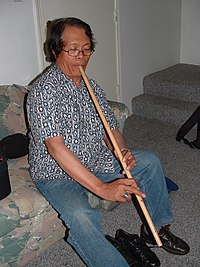
The flute is a member of a family of musical instruments in the woodwind group. Like all woodwinds, flutes are aerophones, producing sound with a vibrating column of air. Unlike woodwind instruments with reeds, a flute produces sound when the player's air flows across an opening. In the Hornbostel–Sachs classification system, flutes are edge-blown aerophones. A musician who plays the flute is called a flautist or flutist.

An aerophone is a musical instrument that produces sound primarily by causing a body of air to vibrate, without the use of strings or membranes, and without the vibration of the instrument itself adding considerably to the sound.

The ocarina is a wind musical instrument; it is a type of vessel flute. Variations exist, but a typical ocarina is an enclosed space with four to twelve finger holes and a mouthpiece that projects from the body. It is traditionally made from clay or ceramic, but other materials are also used, such as plastic, wood, glass, metal, or bone.

The ney, is an end-blown flute that figures prominently in Persian music, Turkish music and Arabic music. In some of these musical traditions, it is the only wind instrument used. The ney has been played continually for 4,500–5,000 years in ancient Egypt, making it one of the oldest musical instruments still in use.

A bansuri is an ancient side blown flute originating from India and Nepal. It is an aerophone produced from bamboo and metal like material used in many nepali lok songs. A bansuri is traditionally made from a single hollow shaft of bamboo with seven finger holes. Some modern designs come in ivory, fiberglass and various metals. The six hole instrument covers two and a half octaves of music. The bansuri is typically between 30 centimetres (12 in) and 75 centimetres (30 in) in length, and the thickness of a human thumb. One end is closed, and few centimeters from the closed end is its blow hole. Longer bansuris feature deeper tones and lower pitches. The traditional design features no mechanical keys, and the musician creates the notes they want by covering and uncovering the various finger holes.

The dizi, is a Chinese transverse flute. It is also sometimes known as the di or héngdi, and has varieties including Qudi, Bangdi, and Xindi. It is a major Chinese musical instrument that is widely used in many genres of Chinese folk music, Chinese opera, as well as the modern Chinese orchestra. The dizi is also a popular instrument among the Chinese people as it is simple to make and easy to carry.

Chinese flutes come in various types. They include

The end-blown flute is a woodwind instrument played by directing an airstream against the sharp edge of the upper end of a tube. Unlike a recorder or tin whistle, there is not a ducted flue voicing, also known as a fipple. Most rim-blown flutes are "oblique" flutes, being played at an angle to the body's vertical axis. A notched flute is an end-blown flute with a notch on the blowing surface. A lip-valley flute is a type of notched flute.

The quena is the traditional flute of the Andes. Traditionally made of cane or wood, it has 6 finger holes and one thumb hole, and is open on both ends or the bottom is half-closed (choked). To produce sound, the player closes the top end of the pipe with the flesh between the chin and lower lip, and blows a stream of air downward, along the axis of the pipe, over an elliptical notch cut into the end. It is normally in the key of G, with G4 being the lowest note. It produces a very "textured" and "dark" timbre because of the length-to-bore ratio of about 16 to 20, which is very unlike the tone of the Western concert flute with a length-to-bore ratio of about 38 to 20.

Music of Jammu and Kashmir reflects a rich musical heritage and cultural legacy of the Indian-administered union territory of Jammu and Kashmir. Two different regions of Jammu and Kashmir consists the Jammu region and Kashmir Valley. Music of Kashmir Valley has influences of Central Asian music while music from Jammu region is similar to that of other regions of North India.
The venu is one of the ancient transverse flutes of Indian classical music. It is an aerophone typically made from bamboo, that is a side blown wind instrument. It continues to be in use in the South Indian Carnatic music tradition. It is referred to as nadi and tunava in the Rigveda and other Vedic texts of Hinduism. In northern Indian music, a similar flute is called bansuri. In the south, it is also called by various other names such as pullanguḻal (புல்லாங்குழல்) in Tamil, oodakuḻal (ഓടകുഴൽ) or kurungu kuḻal in Malayalam (Kerala) and ಕೊಳಲು (koḷalu) or ಮುರಳಿ (muraļi) in Kannada (Karnataka). It is known as pillana grōvi or vēṇuvu (వేణువు) in Telugu. It is also called as Carnatic Flute.

The xun is a globular, vessel flute from China. It is one of the oldest musical instruments in China and has been in use for approximately seven thousand years. The xun was initially made of stone, baked clay, or bone, and later of clay or ceramic; sometimes the instrument is made with bamboo. It is the only surviving example of an earth instrument from the traditional "eight-tone" (bayin) classifications of musical instruments.

The xiao is a Chinese vertical end-blown flute. It is generally made of bamboo. It is also sometimes called dòngxiāo, dòng meaning "hole." An ancient name for the xiāo is shùzhúdí but the name xiāo in ancient times also included the side-blown bamboo flute, dizi.

The danso is a Korean notched, end-blown vertical bamboo flute used in Korean folk music. It is traditionally made of bamboo, but since the 20th century it has also been made of plastic. It was imported from China in the 19th century, where it is called duanxiao. The Korean name is the transliteration of the Chinese one, a short variant of the xiao.
The sogeum is a small bamboo transverse flute used in traditional Korean music. Unlike the larger daegeum, it does not have a buzzing membrane. It is used in court, aristocratic, and folk music, as well as in contemporary classical music, popular music, and film scores.

The Jiahu gǔdí are the oldest known musical instruments from China, dating back to around 6000 BCE. Gudi means "bone flute" in Chinese.

The tunso is a Korean notched, end-blown vertical bamboo flute used in Korean traditional music. It is similar to the danso, but longer and larger. The hanja tong(洞) was used to describe the shape of the instrument that resembles a long cave.
Fue (笛/ふえ) is the Japanese word for bamboo flute, and refers to a class of flutes native to Japan. Fue come in many varieties, but are generally high-pitched and made of a bamboo called shinobue. The most popular of the fue is the shakuhachi.





















































